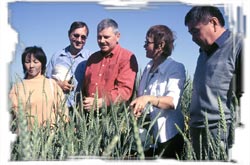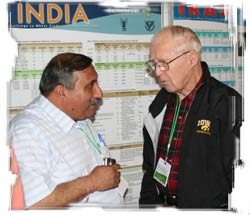CIMMYT E-News, vol 3 no. 3, March 2006
 Scientists talk wheat at the place where the green revolution began
Scientists talk wheat at the place where the green revolution began
Prominent players in global wheat research—hailing from Azerbaijan to Zimbabwe and about 20 countries in between—arrived at Ciudad Obregón, Mexico in late March to chart a course for wheat research in the developing world for the coming decade.
Approximately 130 participants attended the weeklong “International Symposium on Wheat Yield Potential: Challenges to International Wheat Breeding,” sponsored by CIMMYT and the Australian Centre for International Agricultural Research (ACIAR).
“This symposium has been a tremendous opportunity for sharing ideas and learning right across the world’s wheat research fraternity,” concludes Tony Fischer, ACIAR Program Advisor for South Asia. “The representation from both the developing and the developed world is very good and we once again see that in the developing world innovation system CIMMYT continues to play a huge leadership role.”
“The original purpose,” says symposium organizer and CIMMYT wheat physiologist Matthew Reynolds, “was to disseminate new technologies that would improve the efficiency of wheat breeding in lesser developed countries. We achieved that and much more. We delivered the results of our ACIAR project on early generation selection and improved understanding of the fundamental constraints to yield potential, but then went on to a wide range of very topical subjects covered by top experts in the field.”

The meeting opened with a keynote address by Dr. Norman Borlaug entitled “Personal Reflections of 62 Years of Fighting Hunger.” Following the warmly received address, the symposium got down to business with a series of 40 technical presentations. A poster session addressing wheat breeding and production (and related constraints) in 17 countries ensured that NARS perspectives were well represented. The concluding day of the meeting was devoted to breakout and reporting sessions to define wheat research initiatives and explore the roles of CIMMYT, advanced research institutes, and NARS in putting the plans into action.
CIMMYT held a similar meeting nearly ten years ago to the day, which focused primarily on increasing yield potential, breeding for drought, and the use of molecular tools. While these items, particularly water use efficiency, remain high on CIMMYT’s agenda, the symposium participants observed that the world wheat situation and agriculture generally is rapidly changing, and consequently, new priorities have emerged. NARS representatives flagged high priority issues such as conservation agriculture, the need for higher quality wheat bred for specific food and industrial uses, and breeding with climate change in mind, notably heat stress.
| Bayan Alimgazinova, Deputy Director, Science Department, Ministry of Agriculture of Kazakhstan
“CIMMYT provides and facilitates the exchange of germplasm and this is very important for our breeding efforts. The Kazakhstan-Siberia Network for Spring Wheat (KASIB) is a good example of this. It’s a new type of collaboration for us, with the shuttle breeding, traveling seminars, and other activities. We’ll be studying more than 1,000 entries in the trials and many of these will be useful for Kazakhstan. Our varieties go out as well. The impact of this is multiplied because all of the information from the trials and conferences gets published in journals (in Russian), as do a range of other publications and training course materials. CIMMYT is the main reason this is happening. A small but important component of our relationship with CIMMYT is the interaction with the outside scientific community that they provide to Kazak scientists.” |
There were a number of exciting new ideas that emerged from this symposium, says Hans Braun, Director of the CIMMYT Wheat Program, “all of which depend on ever closer links between scientists in the international wheat community. In our final sessions we crystallized these into research thrusts that we would like to incorporate into our existing program.”
Braun said three major areas cited for more intensive research emerged from the interactions:
- Integration of physiological trait-based approaches into conventional breeding schemes to advance progress on complex traits associated with yield and stress adaptation. This entails dissecting yield into its physiological components and using conceptual models to increase the likelihood of combining complementary genes to capture the desired trait. CIMMYT terms this use of physiological markers physiological breeding or “smart crossing.”
- More systematic characterization of target environments than in the past. Combining comprehensive environment data with CIMMYT’s exceptional and extensive phenotypic data of genotypes will greatly expand our knowledge about genotype x environment interaction. This will be further catalyzed by new tools and methodologies in the areas of geographic information systems, advanced statistics, modeling, and bioinformatics.
- Conservation agriculture (CA) was strongly endorsed as a strategy for buffering the adverse effects of environment on crop yields, especially in the face of climate change and reduced water resources. This is in addition to CA’s role in stabilizing the natural resource base and reducing long-term dependence on agro-chemical inputs.
For further information contact Matthew Reynolds (m.reynolds@cgiar.org)

